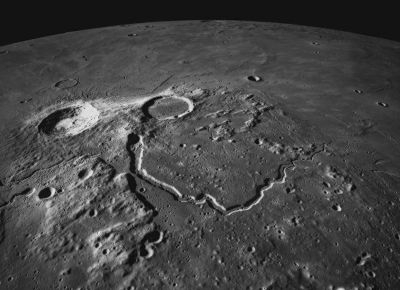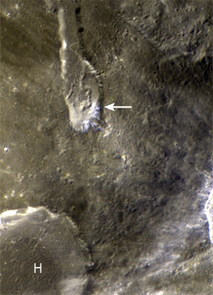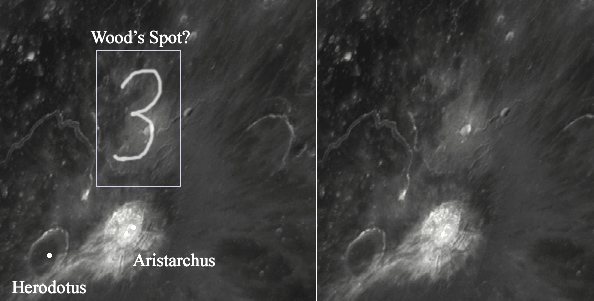Aristarchus Plateau
Contents
Aristarchus Plateau
(informal name)
|
Lat: 26.4°N, Long: 50.4°W, Diameter: 230 km, Height: km, Rukl: 18 | |
Table of Contents
[#Aristarchus Plateau Aristarchus Plateau]
[#Aristarchus Plateau-Images Images]
[#Aristarchus Plateau-Maps Maps]
[#Aristarchus Plateau-Description Description]
[#Aristarchus Plateau-Additional Information Additional Information]
[#Aristarchus Plateau-Nomenclature Nomenclature]
[#Aristarchus Plateau-LROC Articles LROC Articles]
[#Aristarchus Plateau-LPOD Articles LPOD Articles]
[#Aristarchus Plateau-Lunar 100 Lunar 100]
[#Aristarchus Plateau-Bibliography Bibliography]
Images
LPOD Photo Gallery Lunar Orbiter Images Apollo Images
- Apollo Image of the Week
- HDTV image from Kaguya.
- Russell Croman: The Aristarchus Plateau (the color of Wood's Spot).
Maps
(LAC zone 39D1) LAC map Geologic map LM map LRO LOLA Topo Map (See 4.02.2010)
Description
The rectangular slightly domed area cut through by Schröter's Valley.
Additional Information
- Very large pyroclastic deposit (area = 37,400 km^2) covers Aristarchus Plateau and parts of nearby mare. Gaddis, L. (1999) Lunar Pyroclastic Volcanism Project.
- Two points on the Aristarchus plateau (Aristarchus 1 and Aristarchus 2) were designated as Constellation Regions of Interest.
- Wood's Spot
- Clementine views (left image annotated) using LTVT as a projection method.
- Image above shows the possible location of Wood's Spot shown in rectangle (top = North, East = left). According to Wood's descriptions in his 1910 paper (p. 71) entitled "The Moon in Ultra-Violet Light, and Spectro-Selenography" "The deposit is shaped like a figure 3", and in his 1912 paper (p. 79) entilted "Selective Absoption of Light on the Moon's Surface and Lunar Petrography", "It may be an ash containing sulphur or it may be a deposit of sulphur formed by condensation of ejected vapour. It seems probable, however, that it is due to sulphur". From these papers the "figure 3" comment, undoubtedly, is the key as to what Wood was describing (annotated as a 3 in the left-most image), however, as Patrick Moore says in his book "A Survey of the Moon" (p. 121), "He never followed up the work with more elaborate apparatus, but the existance of 'Wood's Spot' as it came to be called, was confirmed in 1926 by F. E, Wright at the Lick Observatory." - JohnMoore2 JohnMoore2
- One doesn't need high color-sensitivity to observe the curious green and violet near Aristarchus. Gruithuisen seems to have been the first one who observed the typical green of the quadrangular spot west/northwest of Aristarchus, of which he compared the colors (yellowish-greens) with those of terrestrial woods, meadows, and cornfields. Even the not experienced observer could catch this yellowish-green region in the wink of the eye. -Translated from the Dutch book Op Ontdekking in het Maanland by A.J.M.Wanders, 1949.- DannyCaes DannyCaes Aug 14, 2010
Nomenclature
- Named after Aristarchus, the most prominent feature on the Plateau.
- Also known as Wood's Spot, after R.W. Wood who discovered in 1910 that the plateau was dark in the ultraviolet, giving it a yellowish color. Observed through common telescopes it (Wood's Spot) looks kind of mustard-colored (a mixture of grey and mustard-green or light khaki-green).- DannyCaes DannyCaes Aug 9, 2010
LROC Articles
Aristarchu Plateau (1): Amazing Geologic Diversity.
Aristarchu Plateau (2): Pyroclastic Deposit.
Rille within a rille.
LPOD Articles
Equal Rims? Colorful Aristarchus Plateau Aristarchian Colors Aperture
Lunar 100
L22: Mysterious uplifted region mantled with pyroclastics.
Bibliography
- Bruce A. Campbell, Lynn M. Carter, B. Ray Hawke, Donald B. Campbell and Rebecca R. Ghent (2008). Volcanic and impact deposits of the Moon's Aristarchus Plateau: A new view from Earth-based radar images. Geology; February 2008; v. 36; no. 2; p. 135-138.
- McEwen, A.S. & 5 others (1994). Clementine observations of the Aristarchus region of the Moon. Science 266, 1858-1862.
- Wood, C.A. 2004. The Aristarchus plateau. S&T Jan 2004 v107 p124.
- Wood, C.A. 2005. Color and History on the Aristarchus Plateau. Sky and Telescope. Feb. 2005:63.
- Wood, R. W. 1910. Moon in yellow and ultra-violet light, Monthly Notices of the Royal Astronomical Society, Vol. 70, p. 226.
- Wood, R. W. 1910. The Moon in Ultra-Violet Light, and Spectro-Selenography, Popular Astronomy, vol. 18, pp.67-72.
- Wood, R. W. 1912. Selective Absorption of Light on the Moon's Surface and Lunar Petrography. Astrophysical Journal, vol. 36, p.75.
- Zisk, S.H. and 6 others (1977). The Aristarchus-Harbinger region of the Moon: Surface geology and history from recent remote sensing observations. Moon 17, 59-99.
- APOLLO OVER THE MOON; A VIEW FROM ORBIT, Chapter 6: Rimae (Part 3: Straight Rimae), Figure 219.
- About the mustard-colored region which is unofficially named Wood's Spot: A.J.M.Wanders's Op Ontdekking in het Maanland, Het Spectrum, 1949.
- Wood's Spot is also described in V.A.Firsoff's The Old Moon and the New, Sidgwick & Jackson, 1969, page 193.
This page has been edited 1 times. The last modification was made by - tychocrater tychocrater on Jun 13, 2009 3:24 pm - mfx1u2


